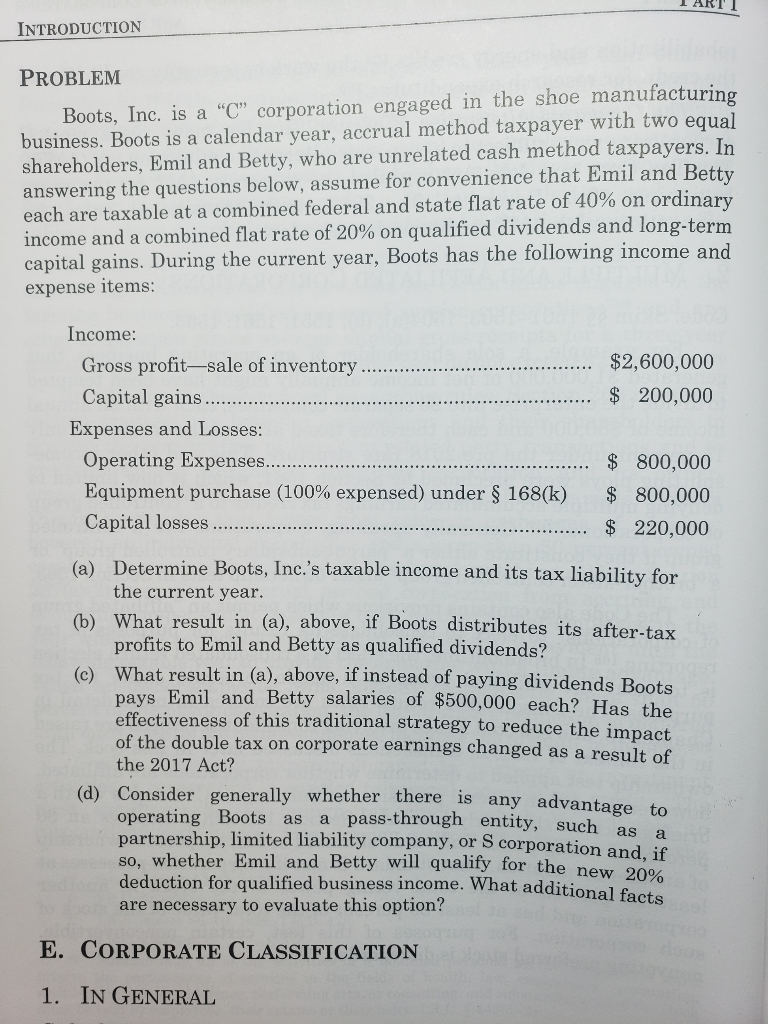From: Fundamentals of Corporate Taxation 10th edition (2019)
page 28

INTRODUCTION PROBLEM Boots, Inc. is a C corporation engaged in the shoe manufacturing business. Boots is a calendar year, accrual method taxpayer with two equal shareholders, Emil and Betty, who are unrelated cash method taxpayers. In answering the questions below, assume for convenience that Emil and Betty each are taxable at a combined federal and state flat rate of 40% on ordinary income and a combined flat rate of 20% on qualified dividends and long-term capital gains. During the current year, Boots has the following income and expense items: $2,600,000 $ 200,000 Income: Gross profit-sale of inventory Capital gains Expenses and Losses: Operating Expenses. Equipment purchase (100% expensed) under $ 168(k) Capital losses $ 800,000 $ 800,000 $ 220,000 (a) Determine Boots, Inc.'s taxable income and its tax liability for the current year. (b) What result in (a), above, if Boots distributes its after-tax profits to Emil and Betty as qualified dividends? (c) What result in (a), above, if instead of paying dividends Boots pays Emil and Betty salaries of $500,000 each? Has the effectiveness of this traditional strategy to reduce the impact of the double tax on corporate earnings changed as a result of the 2017 Act? (d) Consider generally whether there is any advantage to operating Boots as a pass-through entity, such partnership, limited liability company, or Scorporation and, if so, whether Emil and Betty will qualify for the new 20% deduction for qualified business income. What additional facts are necessary to evaluate this option? as a E. CORPORATE CLASSIFICATION 1. IN GENERAL INTRODUCTION PROBLEM Boots, Inc. is a C corporation engaged in the shoe manufacturing business. Boots is a calendar year, accrual method taxpayer with two equal shareholders, Emil and Betty, who are unrelated cash method taxpayers. In answering the questions below, assume for convenience that Emil and Betty each are taxable at a combined federal and state flat rate of 40% on ordinary income and a combined flat rate of 20% on qualified dividends and long-term capital gains. During the current year, Boots has the following income and expense items: $2,600,000 $ 200,000 Income: Gross profit-sale of inventory Capital gains Expenses and Losses: Operating Expenses. Equipment purchase (100% expensed) under $ 168(k) Capital losses $ 800,000 $ 800,000 $ 220,000 (a) Determine Boots, Inc.'s taxable income and its tax liability for the current year. (b) What result in (a), above, if Boots distributes its after-tax profits to Emil and Betty as qualified dividends? (c) What result in (a), above, if instead of paying dividends Boots pays Emil and Betty salaries of $500,000 each? Has the effectiveness of this traditional strategy to reduce the impact of the double tax on corporate earnings changed as a result of the 2017 Act? (d) Consider generally whether there is any advantage to operating Boots as a pass-through entity, such partnership, limited liability company, or Scorporation and, if so, whether Emil and Betty will qualify for the new 20% deduction for qualified business income. What additional facts are necessary to evaluate this option? as a E. CORPORATE CLASSIFICATION 1. IN GENERAL







